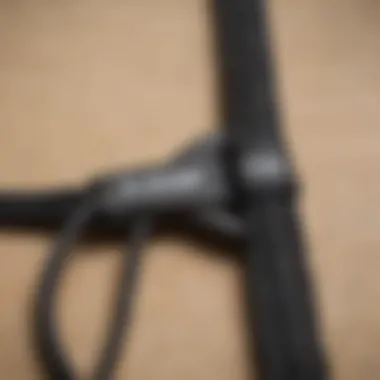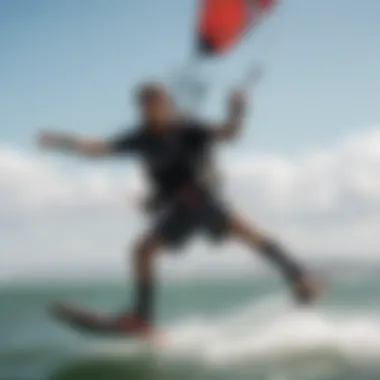The Kite Leash: Importance and Functionality Explained


Intro
Kiteboarding, a fascinating blend of surfing and flying, demands not only skill but also an understanding of the essential gear that ensures safety and enhances enjoyment on the water. At the heart of this gear is the kite leash, a component that often goes unnoticed until it’s needed most. Its significance cannot be overstated as it serves to connect the rider to the kite, providing stability, control, and crucially, safety.
Understanding the importance of the kite leash involves exploring its design, materials, and specific functions. For seasoned riders and newcomers alike, this knowledge is critical in crafting a kiteboarding experience that is both exhilarating and secure. The kite leash is not just a tether—it’s a lifeline that can influence performance in wind conditions, facilitate tricks, and protect riders from potentially dangerous situations.
In this guide, readers will find insights into various types of kite leashes, recommendations tailored for different skill levels, and tips on maintenance practices to prolong their gear's life. Moreover, advancements in leash technology will be discussed, providing kiteboarders with information on the latest innovations enriching their experience on the water.
Let’s dive deep into the world of kite leashes and open up the fascinating discussion about their undeniable value in kiteboarding.
Understanding the Kite Leash
When it comes to kiteboarding, the kite leash isn’t just an accessory; it’s a crucial element that can make or break your experience on the water. Understanding the kite leash allows kiteboarders to fully appreciate its roles in safety, control, and overall performance. As the saying goes, ‘an ounce of prevention is worth a pound of cure.’ In this case, knowing the ins and outs of the kite leash could save you from unwanted mishaps while enhancing your capabilities.
The kite leash serves multiple purposes beyond simply tethering the kite to the rider. It provides a line of defense against equipment failure, grants the kiteboarder a level of control during maneuvers, and introduces safety features that are integrated into more advanced designs. In crowded spots or when the winds turn nasty, an effective kite leash can be a real life-saver.
Definition and Purpose
At its core, a kite leash is a line that connects a rider’s harness to the kite. This essential piece of gear allows riders to maintain control over the kite, aiding in repositioning, emergency scenarios, and even executing tricks. To put it plainly, without a kite leash, a drop in the kite could lead to abrupt and often dangerous situations.
Not only does the leash serve as a physical connection, but its design has specific functionalities tailored to the kiteboarding environment. A well-designed leash can enhance the rider’s ability to manage the kite's position, effectively reducing the risk of accidents. It often incorporates features such as quick-release mechanisms, which can be the difference between a thrilling ride and a hazardous experience.
Historical Context
The evolution of the kite leash traces back to the days when kiteboarding was merely a niche sport. In the early days, riders relied on simple, rudimentary designs. These initial leashes were often prone to failure, leading to numerous accidents, some of which could have been avoided with better technology and design.
As kiteboarding gained popularity, manufacturers took notice. Over the years, kite leashes have undergone considerable transformation, transitioning from basic rope-like attachments to the sophisticated, multi-function systems we see today. Innovations sparked by both necessity and competition in the industry have led to the development of safety leashes, emergency release systems, and materials that resist wear and tear.
The introduction of safety regulations and an increased awareness of rider safety ultimately propelled the advancement of kite leash design. Today’s leashes come equipped with features designed to cater to varying conditions and riding styles, ensuring greater versatility and security.
It's important for both novices and seasoned kiteboarders to grasp this historical context, as it provides them with a deeper respect for what they use. Knowing how far the kite leash has come can enhance a rider's understanding of its significance in today’s kiteboarding world.
"Safety comes first, so understanding your equipment and its history is paramount in ensuring enjoyable kiteboarding experiences."
In summary, the kite leash is not merely a piece of string connecting you to your kite; it’s a critical component of the kiteboarding experience that has evolved dramatically over the years. Understanding its purpose and historical background ultimately arms you with information that could elevate your performance and enhance your safety on the water.
Types of Kite Leashes
Kite leashes come in various shapes and sizes, and understanding their types is crucial for both safety and performance on the water. Just like choosing the right fishing rod can make or break your day on the lake, selecting the appropriate kite leash directly impacts your kiteboarding experience. Each type of leash serves a specific purpose, catering to different styles of riding and conditions. Knowing these can help you make a smart choice, especially if you're a novice or even a seasoned kiteboarder looking to refine your gear.
Standard Leash
The standard leash is the bread-and-butter of kiteboarding, often found attached to most kites. This leash is designed to provide basic safety while giving the rider control over their kite. Typically made from durable materials, it connects the rider to the kite via a quick-release mechanism, allowing the rider to detach if the situation demands it.
A critical aspect of the standard leash is its length and flexibility. Generally ranging between 3 to 5 feet, the leash should allow enough room for maneuverability. If the leash is too long, it can lead to excessive slack, making it harder to regain control if the kite flutters. On the other hand, a leash that’s too short can inhibit your movements, leading to undesirable crashes.
It also plays a role in how the kite behaves in the air. A well-designed standard leash can influence the kite's responsiveness, essential when executing tricks or navigating tricky conditions. Without a doubt, it represents an essential component of any kiteboarding setup.
Safety Leash
Safety must always be top of mind when kiteboarding, which is where the safety leash comes into play. This leash is primarily focused on ensuring that the rider can quickly disconnect from their equipment if necessary. Think of it as the fire extinguisher in your home; you hope to never use it, but it's crucial to have just in case.
Safety leashes are often equipped with emergency release systems, designed to ensure that in a dangerous situation where the rider loses control, they can detach from the kite almost instantly. Because the last thing anyone wants is to be dragged across the water or worse. Many kiteboarders use a combination of a standard and a safety leash for optimal performance alongside safety.
In terms of design, safety leashes are made from robust materials to withstand the stresses of being in tough conditions while offering ease of detachment. They often include features like foam padding to minimize the risk of injury to the rider or anyone nearby. Every kiteboarder should consider carrying a safety leash as part of their essential gear.
Multi-Function Leash
As kiteboarding evolves, so do the accessories and gear. The multi-function leash stands out as a versatile option available to both amateurs and seasoned professionals alike. This leash combines elements of the standard and safety leashes, creating a hybrid option that addresses multiple needs.
A multi-function leash often allows for quick attachment and detachment while also featuring padding for comfort. Some designs even incorporate additional features like built-in buoyancy or reflective surfaces for visibility. This versatility makes it suitable for various conditions, from cruising in calm waters to tackling waves.
Moreover, multi-function leashes can often adapt to different users. For a rider who enjoys switching styles or trying out different tricks, this leash offers flexibility. The multifaceted nature of such leashes means you won't have to keep purchasing new leashes as your skills develop or your riding style changes.
"Choosing the right kite leash is as important as picking the kite itself. Your choice reflects your riding style, safety preferences, and how you tackle challenges on the water."
In summary, understanding the different types of kite leashes—be it the standard, safety, or multi-function variety—forms the bedrock of a successful kiteboarding experience. The right leash will not only ensure your safety but also enhance your overall performance, letting you reach new heights both literally and figuratively.


Materials Used for Kite Leashes
The kite leash serves an essential role in the kiteboarding experience, and understanding the materials that comprise these leashes is absolutely crucial. Each type of material has specific properties that influence not only the performance of the leash but also its longevity, safety aspects, and user comfort. Selecting the right material can make the difference between an enjoyable ride and a hasty return to shore.
Nylon
Nylon is often the go-to choice for kite leashes primarily because of its strength and flexibility. This synthetic fabric holds up remarkably well against abrasive surfaces, such as sand and saltwater. Moreover, nylon’s elasticity allows for some stretch, which can help absorb the shocks of sudden movements while riding.
However, no material is without its downside. Nylon can degrade in direct sunlight over time. That means if you’re out riding day in and day out, you might find your leash wearing a bit faster than expected. Regularly checking for frays or weak points becomes top priority. It’s important to note that some brands use UV-resistant coatings as a way to combat this degeneration, which can be a beneficial factor when you’re deciding which nylon leash to choose.
Polyester
Polyester is another popular material used in kite leashes, known for its durability and resistance to water absorption. If you plan on spending a lot of time on the water, polyester leashes can potentially remain lighter since they don’t soak up moisture like nylon. They also resist fading and maintain their color over time, making them a favorable option for many kiteboarders focused on aesthetics as well as function.
One drawback, however, involves polyester’s lower elasticity. While this might sound unfavorable, it can actually provide better kite control once you’re in the air. This reduced stretch can lead to more responsive handling, allowing experienced riders to perform tricks with ease. Choosing between a nylon and a polyester leash will depend heavily on the rider’s preferences and conditions in which they kite.
Reinforced Materials
In a world where the motto "stronger is better" rings true, reinforced materials are gaining traction in the kiteboarding community. The latest innovations utilize combinations of fibers, sometimes mixing nylon with materials like Dyneema. Dyneema is known for being exceptionally strong and lightweight, offering impressive tensile strength while minimizing bulk.
These reinforced leashes can withstand extreme stress and conditions, making them a top choice for riders who push their limits, whether in harsh winds or waves. Of course, the price tag often reflects the advanced technology, thus appealing more to serious enthusiasts than to casual hobbyists. But considering the advantages, the investment could be well worth it.
"A kite leash isn’t just a piece of equipment; it’s a lifeline. Understanding the materials behind it can mean the difference between safety and a risky adventure."
In summary, the materials used in kite leashes—be it nylon for flexibility, polyester for durability, or reinforced options for superior strength—play a pivotal role in how effectively and comfortably one can ride. By recognizing the benefits and limitations of these materials, kiteboarders can make informed decisions that suit their personal style and the conditions they encounter.
The Role of the Kite Leash in Safety
The kite leash is not just a piece of equipment; it is a lifeline that plays a significant part in ensuring the safety of kiteboarders. Its role goes beyond connecting the kite to the board and serves as a critical component in emergency situations, stability, and overall rider safety. Being aware of the leash’s functionality and its influence on your kiteboarding experience is essential.
Emergency Release Systems
When kiteboarding, we are often at the mercy of wind and water. The unpredictable nature of these elements calls for an efficient emergency release system. This system acts like a magic button in a sticky situation – instantly disconnecting the rider from the kite. Riders might find themselves in situations that feel like they’ve been tossed into a washing machine when strong winds push the kite erratically. An emergency release mechanism allows one to regain control swiftly and ensures that if there’s a mishap, the rider can detach themselves from the kite to avoid injury.
One effective method is to use a quick-release harness, which should be easily accessible. During hurried moments, fumbling around for a disconnect could lead to unfortunate outcomes, so getting familiar with the particular design of your equipment is wise. A well-designed release system will let the user disengage without having to think too much about it.
"In safety, knowledge isn’t just power; it’s a lifeline that keeps you afloat."
Reducing Risks of Equipment Failure
Equipment failure is always lurking in the background, ready to throw a spanner in the works. Given that kiteboarding pushes both the rider and the gear to their limits, the integrity of the kite leash is paramount. If the leash fails, it can result in loss of kite control, causing unpredictable and sometimes dangerous situations.
Regular checks on the leash’s condition can drastically reduce risks associated with equipment failure. Look for any abrasion or frays in the material, as wear and tear can sneak up on you. It’s also important to ensure that attachments to both the kite and the harness are secure.
Optting for a leash that uses high-density materials like reinforced nylon or polyester can also enhance safety. Even though it might be tempting to cut corners on costs, investing in quality gear can make all the difference when faced with adverse conditions.
In sum, the kite leash plays a vital role in kiteboarding safety. By understanding its emergency release systems and the importance of maintaining the leash to prevent equipment failure, riders can enjoy their time out on the water, ensuring they stay safe while chasing the wind.
Performance Aspects of Kite Leashes
Understanding how a kite leash performs is crucial for any kiteboarder who wants to maximize their experience on the water. Performance aspects encompass various elements that not only influence control but also affect how tricks and maneuvers are executed. A well-performing kite leash contributes to overall stability and responsiveness, allowing the rider to harness the kite's full potential effectively.
Influence on Kite Control
A kite leash is fundamental when it comes to maintaining the relationship between the rider and the kite. The leash's length, elasticity, and overall design play significant roles in this context. Longer leashes often provide greater freedom of movement, but they can also introduce additional challenges in controlling the kite’s position. Conversely, shorter leashes can enhance precision, giving the rider more direct input into the kite's behavior in the air.
- Key Points on Influence:
- Length matters: Longer leashes allow for more freedom but may make control trickier. Shorter leashes offer precise control but restrict freedom slightly.
- Material elasticity: Different materials exhibit varying levels of stretch. For instance, a nylon leash can absorb shock better than a rigid accessory. This affects how the kite responds to sudden movements.
- Knots and attachments: Improperly tied knots can lead to sudden failures, affecting how easily you can steer the kite. A well-knotted, secure leash allows for responsive control.
A rider’s experience level can significantly influence how they manage their kite leash. For beginners, understanding these dynamics is essential as they learn to balance control with freedom. For more experienced riders, the choice of leash can become a matter of personal preference, affecting their riding style.
Impact on Trick Execution
The ability to perform tricks in kiteboarding can hinge on how well the leash interacts with the kite and the rider. Specifically, the leash's responsiveness impacts how the rider can manipulate the kite during aerial maneuvers. When a kite leash is optimized, it can mean the difference between landing smoothly and crashing into the water.
Here’s how leash performance affects trick execution:


- Flow Control: A leash that allows for quick reactions enables smoother transitions between tricks. Therefore, if a rider is attempting to go from one trick to another, their kite needs to respond without lag.
- Aerial Stability: Tricks like backflips or rotations require the rider to maneuver the kite accurately in the air. A well-performing leash provides stability which is crucial for the kite to maintain its intended flight path.
- Feedback Transfer: An efficient leash can relay feedback from the kite to the rider more effectively, allowing for better adjustments during a trick. When you feel more connected to the kite, executing intricate tricks becomes instinctual.
"Proper leash performance transforms an average run into a showstopper. It gives the rider that extra edge to nail a trick and brush off the falls."
In summary, every kiteboarder must consider the performance aspects of their leash, balancing control and freedom in their particular style. Choosing the right combination ensures that they can handle tricky maneuvers gracefully while maximizing their enjoyment out on the water.
Common Issues with Kite Leashes
Understanding the common issues associated with kite leashes is crucial for both safety and performance in kiteboarding. Kite leashes function as the vital link between the kiter and the kite, ensuring control and safety. However, neglecting certain common problems can lead to serious consequences in the field. Therefore, recognizing potential pitfalls regarding wear and tear, as well as improper attachment techniques, can not only enhance one's overall kiteboarding experience but also prolong the lifespan of this essential equipment.
Wear and Tear
Just like your favorite pair of shoes, kite leashes experience wear and tear from frequent use. Factors such as UV exposure, saltwater, and general grit can gradually damage the leash materials over time. It’s not unusual for the leash to become frayed or weakened due to harsh conditions.
- Impact of Environmental Factors: Exposure to sunlight can weaken nylon or polyester fibers, leading to potential failures during critical moments. Saltwater can corrode metal clips, making them less reliable.
- Signs of Wear: Look for discoloration, visible fraying, or weak points in the leash. These signs act like red flags; ignoring them is a risk not worth taking.
- Replacement Considerations: If you notice any wear, it might be wise to replace the leash instead of pushing your luck. After all, your safety is paramount, and a reliable leash can make a world of difference.
A common practice among seasoned kiteboarders is to carry a spare leash. This ensures that, should a failure occur, you’re still in the game, ready to fly once again.
Improper Attachment
Another significant issue that kiteboarders face is improper attachment of the kite leash. While it may seem straightforward, this crucial step is where many make mistakes. A leash that isn't attached correctly can lead to immediate danger, causing the kite to behave unpredictably or even detach altogether.
- The Right Clips and Knots: Choose the correct clips that can withstand the force of an unexpected gust. Equally important is mastering the correct knot tying techniques to ensure that the leash remains securely fastened.
- Frequent Checks: Make it a habit to inspect the attachment points before gearing up. Is it easy to see the attachment site? If not, consider using brightly colored lanyards or tape. A visible attachment is a reminder to double-check.
- User Error: It's easy to rush during setup, especially if you're excited to hit the water. Take that extra moment to ensure everything is in place, as it could mean the difference between a fun day on the water and an emergency situation.
"A small oversight can lead to big problems; prevention is better than cure."
In summary, understanding issues like wear and tear, along with ensuring proper attachment of the kite leash, are essential skills for every kiteboarder. By paying close attention to these common problems, you can minimize risks and enhance your overall kiteboarding experience.
Maintenance and Care for Kite Leashes
When it comes to kiteboarding, the kite leash often takes a backseat in discussions around gear maintenance. However, taking good care of your kite leash is not just a matter of longevity; it directly impacts your safety and performance on the water. Just as one wouldn't disregard the upkeep of a trusty surfboard or a reliable set of fins, your kite leash requires the same level of attention.
By engaging in regular maintenance procedures, kiteboarders can ensure that the leash remains functional and safe when it's time to hit the waves. Moreover, understanding how to properly inspect, clean, and store your leash can lead to a significantly enhanced kiteboarding experience.
Regular Inspections
Conducting regular inspections of your kite leash is essential. Not every rider is aware of the wear and tear that can accumulate over time. It’s not just about checking for fraying or knots; a thorough inspection helps identify potential issues before they escalate into serious problems.
Here’s a breakdown of elements to consider during your inspection:
- Visual Inspection: Look for any visible damage, such as fraying, cuts, or knots in the material. A compromised leash can lead to catastrophic failures.
- Attachment Points: Ensure that all connection points—like loops and clips—are secure and show no signs of stress.
- Material Integrity: Check the leash for signs of degradation like stiffness or brittleness, especially if made of synthetic materials.
- Check for Salt Buildup: If you kite in saltwater, inspect for salt deposits which can affect the leash integrity over time.
If you notice any red flags during these checks, it might be an indication that your leash has run its course, or it might just need a bit of maintenance.
Cleaning and Storage
Another key aspect of care is cleaning your kite leash after use. Saltwater, sand, and even fresh water can contribute to the deterioration of the leash’s materials. A few minutes spent washing your leash can extend its lifespan considerably.
Cleaning Steps:
- Rinse with fresh water: After each session, rinse the leash thoroughly to remove any salt, sand, or debris. This simple step prevents corrosion and buildup that could weaken the material.
- Soak if necessary: If your leash is particularly dirty, soak it in a mixture of water and mild soap for a short time. Avoid harsh chemicals, as they can erode the leash’s materials.
- Air Dry: Lay flat on a clean surface to dry. Hanging it can cause stretching, so it’s best to avoid that.
Storage Recommendations:
- Cool, Dry Place: Store your leash away from direct sunlight and extreme temperatures. The heat can break down the material.
- Avoid Folding: Instead of folding the leash, roll it up carefully to avoid creasing the fibers.
- Separate from Other Gear: Keep the leash away from other pieces of equipment that may have sharp edges or points that could damage the leash.
Proper storage and cleaning of your kite leash can mean the difference between a great session and a loss of control at a crucial moment.
Caring for your kite leash proactively helps maintain its functionality, ultimately leading to a safer and more enjoyable kiteboarding experience. As they say, an ounce of prevention is worth a pound of cure.
Innovations in Kite Leash Technology
In the ever-evolving world of kiteboarding, advancements in kite leash technology are proof that innovation is king. Kite leashes have embraced new technologies that elevate the sport's safety, performance, and enjoyment. Knowing the latest trends and touches of modern technology can mean the difference between a good day on the water and a disaster waiting to unfold.
Smart Leashes
Smart leashes represent a remarkable leap forward in kite leash design. They integrate technology that helps kiteboarders keep an eye on their equipment health and conditions. This innovation often includes sensors that provide data on various factors such as tension levels, wear and tear, and even real-time feedback about the location of the kite.


With smart leashes, kiteboarders can receive alerts via mobile applications. Imagine riding out at sea and your leash indicates that it’s time for an inspection or replacement, all while you're still out enjoying the swell. This real-time interaction gives users confidence, allowing for proactive measures before something goes awry.
Another exciting point is the potential for navigation assistance embedded in some smart leash models. This guidance helps the rider avoid hazards in the water, relying on GPS technology to alert them to dangers they might not see, particularly during challenging conditions.
"Technology in kiteboarding is not just about glamour; it’s about survival and performance. The smarter you get, the safer you ride."
Integrated Feedback Systems
Even more astonishing is the integration of feedback systems within kite leashes. These added layers of functionality can measure a kite’s response in various winds and conditions. With such feedback, kiteboarders can adjust their style and technique based on real-time data.
These systems can be predictive as well. For instance, an integrated feedback mechanism could suggest ideal launch times or maneuvers suited to current conditions. By paying attention to this feedback, riders can fine-tune their performance and even expand their tricks repertoire.
Moreover, with the ongoing push toward sustainability, many brands are designing feedback systems that also monitor the leash’s environmental impact. This adds another dimension to kite leash technology, aligning with the growing demand for eco-friendliness in sports gear.
In this tech-focused era, choosing a kite leash equipped with these advanced technologies can boost overall ride quality, fostering a deeper connection between rider and gear. Everyone from amateurs to veterans should keep an eye on these innovations, because the future of kiteboarding is undoubtedly tied to how these technologies advance.
Choosing the Right Kite Leash
Selecting the right kite leash can make or break your kiteboarding experience. The leash is not just a tether; it’s your lifeline between you and your kite. An incorrect choice can lead to safety hazards or performance issues, potentially diminishing your fun on the water.
When it comes to choosing a kite leash, you should consider various factors to ensure that it will meet your specific needs. It’s crucial to analyze how different types of leashes perform under distinct weather conditions, as well as your personal skill level and riding style. This section explores these considerations in detail.
Factors to Consider
- Kite Type: Make sure to choose a leash that's compatible with your kite model and style of riding. For instance, a leash designed for a heavy-duty wake kite may not be suitable for a freestyle kite.
- Length: A leash's length can dramatically affect your maneuverability. Longer leashes can keep the kite farther away while shorter ones provide quicker response times. Think about your riding style. Do you prefer agility or stability?
- Material and Durability: Look for leashes made from high-quality materials that can withstand wear and tear. Nylon and polyester are popular choices. Reinforced materials enhance durability but might add weight, so balance is key.
- Attachment Type: Some leashes attach via a quick-release mechanism, while others require a standard tying method. A quick-release option enhances safety, allowing you to disconnect quickly in emergencies.
- Safety Features: Certain leashes come with integrated safety systems like the emergency release. Familiarize yourself with these options, especially if you're a beginner or ride in big waves.
Remember: Choosing the right leash is akin to selecting the right helmet in biking. It can literally save you from a world of trouble.
Recommendations for Beginners
When beginning your kiteboarding journey, it might feel daunting to choose the correct gear. Here are some pointers to help novices make informed decisions:
- Opt for a Standard Safety Leash: Starting with a standard safety leash is advisable. It keeps your kite close yet manageable, allowing you to learn control without overwhelming you.
- Small Sizes for Light Winds: If you mostly ride in lighter winds, select a shorter leash. They enable better control and make it easier to catch and manage your kite.
- Seek Guidance: Don’t hesitate to ask instructors or experienced kiteboarders for advice during your early days on the water. Their insights could save you a lot of trial and error.
- Try Before You Buy: If possible, test various leashes from friends or rental shops before investing. Experience different lengths and types to discover what suits your style best.
Kite Leashes for Different Conditions
Kiteboarding does not just happen in a one-size-fits-all scenario; the conditions of the water and wind play a pivotal role in how a kite operates. This section highlights the unique requirements and strategies for kite leashes in varying environments, specifically focusing on waves and flat water. Each condition demands different approaches to enhance safety and performance—this is where understanding the kite leash’s adaptability becomes key for any kiteboarder.
Waves
When it comes to riding waves, the kite leash serves as an essential lifeline between the rider and the kite. In this environment, conditions can shift quicker than an unexpected gust of wind. Having the right leash setup helps manage the dynamic forces exerted during a wave session. A shorter leash can provide a more direct connection and tighter control, which is crucial when navigating through the turbulent water and executing tricks. Here are some important considerations:
- Robustness: The leash must be capable of enduring higher tension as the kite generates pull from both the wind and waves. Selecting a leash made from durable materials like reinforced nylon can make a significant difference.
- Quick Release Features: In wave conditions, it’s not just about power; it's also about safety. A good leash should enable a speedy disconnect if a situation escalates, allowing the rider to get free from the kite and any potential hazards in the water.
- Tangle Prevention: The chances of getting the leash tangled during intense sessions increase dramatically. Opt for leashes designed with less-prone tangling features, which can save precious recovery time.
Control during wave riding can often mean the difference between a triumphant ride and a strenuous struggle. Having a leash that fits the scenario is paramount.
Flat Water
Flat water kiteboarding opens a different bouquet of opportunities and challenges. Here, the leash conditions shift from solely focusing on control amidst chop to emphasizing stability and performance. A longer leash is typically favored in these environments, as it allows more freedom of movement and room to navigate larger swells with a gentler hand. Consider these factors:
- Length and Stretch: A slightly longer leash can provide that vital cushion, allowing for a smoother glide when landing tricks. A leash with some elasticity can absorb shocks better during jumps, preventing the rider from feeling jarring impacts.
- Connection Points: Flat water sessions often allow for more varied riding styles and tricks that require agility. Therefore, some riders may prefer a harness leash connection which frees the hands, increasing maneuverability and comfort.
- Safety Mechanisms: Flat water might seem safer, yet unexpected obstacles can appear. A properly functioning emergency release mechanism is still crucial, allowing for quick disengagement if needed.
Understanding these conditions shapes not just the kiteboarding experience, but also maximizes safety and performance. Whether you’re crashing over a wave or skimming smoothly across a flat surface, the kite leash you choose should align with the environment, enhancing your ride rather than constraining it.
The Future of Kite Leashes
As kiteboarding continues to evolve, so too does the technology surrounding kite leashes. Just like any sport, it adapts to meet the demands of its fans. In recent years, networking and innovation have paved the way for advancements that not only enhance safety but also improve performance. This section aims to explore the key elements shaping the future of kite leashes, including predictive technologies and sustainable materials, each bringing a range of benefits and considerations for kiteboarders of all levels.
Predictive Technologies
Predictive technologies integrate smart elements into kite leashes that have the potential to revolutionize the sport. These technologies can harness data analytics to assess environmental factors like wind patterns, rider movements, and even the kite’s performance dynamics. Think of it as a smart assistant giving real-time feedback that helps kiteboarders optimize their rides.
- Sensor Integration: Some kite leashes may come equipped with sensors that monitor how much tension is within the lines. This information is crucial because appropriate tension levels can directly affect control and stability. If a dancer were to let go mid-performance, it could spell disaster; similarly, for kiteboarding, understanding the tension can prevent unwanted detachment.
- App Connectivity: Enhanced technologies will likely allow kite leashes to connect with mobile apps. Users can track performance metrics or receive alerts about gear conditions. Imagine getting a message on your phone that your leash needs a check or is about to wear out—preventing mishaps before they happen.
- Adaptive Adjustments: Future leashes could utilize automatic adjustments based on real-time data, optimizing responsiveness and safety dynamically. A kite leash that adjusts to changing conditions would be akin to a sailing ship that shifts sails without manual input, maximizing performance effortlessly.
Sustainability in Materials
As environmental concerns become a more pressing issue globally, kiteboarding gear, including leashes, is not spared from scrutiny. The future of kite leashes will inevitably embrace sustainable materials, thereby aligning the sport with eco-friendly practices.
- Biodegradable Options: Manufacturers are exploring biodegradable fibers that degrade over time while maintaining performance integrity. This could significantly reduce the long-term impact of discarded gear.
- Recycled Materials: Brands are beginning to use recycled plastics and fibers in their products. Utilizing materials that would otherwise end up in landfills showcases a commitment to sustainability without sacrificing quality. Kiteboarders can feel proud that their leisure activities are contributing to a larger cause.
- Durability Enhancements: Unlike cheap leashes that barely last a season, durable materials that are also environmentally friendly can lead to a longer lifespan for products. Reducing waste comes naturally with durable gear, which necessitates fewer replacements, creating a win-win scenario for enthusiasts and the planet alike.
"The kite leash of the future will be as much a part of the evolution of safety as it will be an ally to nature. Choosing sustainable options can turn a thrilling ride into an environmentally-conscious adventure, one kite at a time."
In a nutshell, kite leashes are poised to reach new heights—pun intended. As we look forward to the future horizons of kiteboarding, these advances underscore the commitment to not only enhancing the rider experience but also preserving the beautiful landscapes that we so reverently enjoy.















